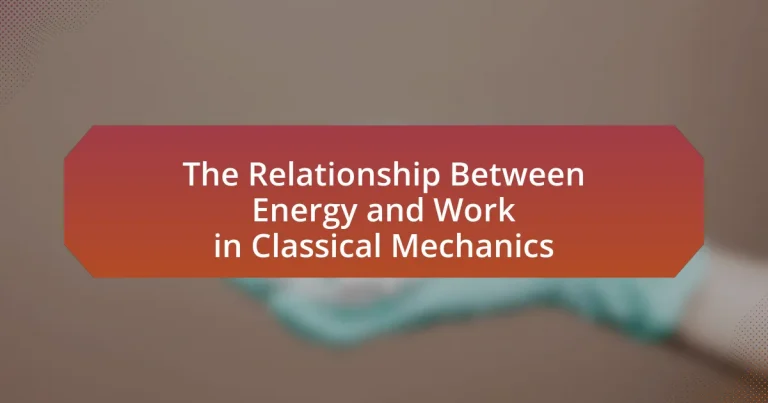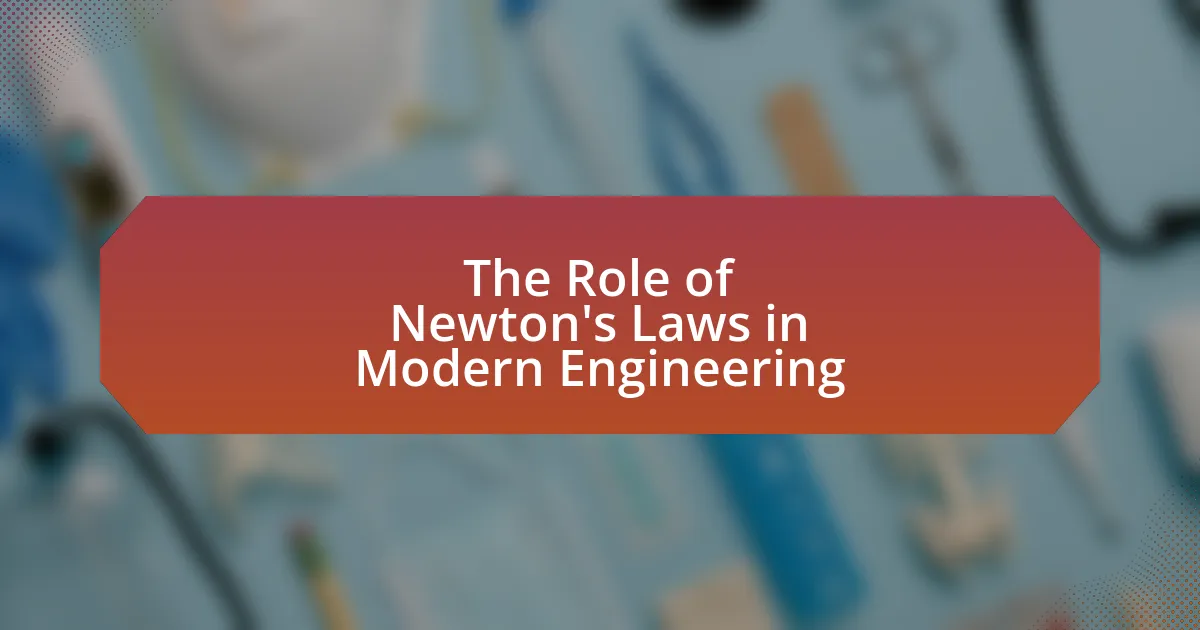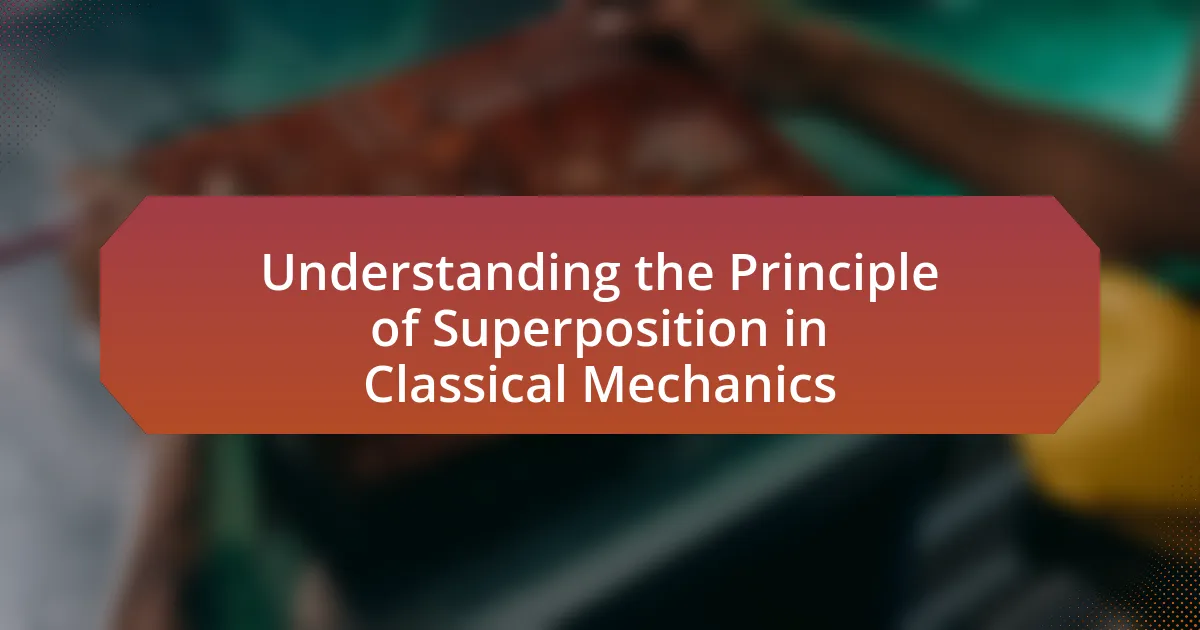The article explores the fundamental relationship between energy and work in classical mechanics, defining work as the transfer of energy when a force is applied to an object. It details how work is calculated using the formula W = F × d × cos(θ) and emphasizes the intrinsic link between work and energy, supported by the work-energy theorem. Various forms of energy, such as kinetic and potential energy, are discussed in relation to work, along with practical applications in engineering and real-world scenarios. The article also addresses the implications of energy conservation, the role of friction, and best practices for optimizing energy use in mechanical systems.

What is the relationship between energy and work in classical mechanics?
In classical mechanics, work is defined as the transfer of energy that occurs when a force is applied to an object, causing it to move. Specifically, the work done on an object is equal to the force applied multiplied by the distance moved in the direction of the force, expressed mathematically as W = F × d. This relationship indicates that when work is performed on an object, energy is transferred to that object, resulting in a change in its kinetic or potential energy. For example, lifting an object against gravity requires work, which increases the object’s gravitational potential energy. Thus, the relationship between energy and work is foundational in classical mechanics, as work is the means by which energy is transferred and transformed.
How are energy and work defined in classical mechanics?
In classical mechanics, energy is defined as the capacity to do work, while work is defined as the transfer of energy that occurs when a force is applied to an object over a distance. Specifically, work is calculated using the formula W = F × d × cos(θ), where W represents work, F is the force applied, d is the distance moved in the direction of the force, and θ is the angle between the force and the direction of motion. This relationship illustrates that energy and work are intrinsically linked; when work is done on an object, its energy changes, either increasing or decreasing depending on the direction of the force applied. The principle of conservation of energy further supports this definition, stating that energy cannot be created or destroyed, only transformed from one form to another, which is foundational in classical mechanics.
What are the different forms of energy relevant to work?
The different forms of energy relevant to work include kinetic energy, potential energy, thermal energy, chemical energy, electrical energy, and nuclear energy. Kinetic energy is the energy of motion, calculated as one-half the mass of an object multiplied by the square of its velocity. Potential energy is stored energy based on an object’s position or configuration, such as gravitational potential energy, which depends on height and mass. Thermal energy relates to the temperature of an object and the motion of its particles, while chemical energy is stored in the bonds of chemical compounds and released during chemical reactions. Electrical energy is associated with electric charges and their movement, and nuclear energy is released during nuclear reactions, such as fission or fusion. Each of these energy forms can be converted into work, demonstrating their relevance in classical mechanics.
How is work calculated in classical mechanics?
Work in classical mechanics is calculated using the formula W = F · d · cos(θ), where W represents work, F is the force applied, d is the displacement of the object, and θ is the angle between the force and the direction of displacement. This equation indicates that work is done when a force causes an object to move in the direction of the force. The cosine factor accounts for the direction of the force relative to the displacement, ensuring that only the component of the force acting in the direction of the displacement contributes to the work done.
Why is the relationship between energy and work important?
The relationship between energy and work is important because work is the process of transferring energy from one system to another. In classical mechanics, this relationship is quantified by the work-energy theorem, which states that the work done on an object is equal to the change in its kinetic energy. This principle is foundational in understanding how forces affect motion and energy transfer, as it allows for the calculation of energy changes in mechanical systems. For example, when a force is applied to move an object, the work done results in an increase in the object’s kinetic energy, demonstrating the direct link between energy input and motion.
How does this relationship apply to real-world scenarios?
The relationship between energy and work in classical mechanics applies to real-world scenarios by illustrating how energy transfer occurs through work done on or by objects. For instance, when a car accelerates, the engine performs work on the vehicle, converting chemical energy from fuel into kinetic energy, which can be quantified using the work-energy theorem. This theorem states that the work done on an object equals the change in its kinetic energy, a principle that is foundational in engineering and physics. In practical applications, this relationship is crucial for designing efficient machines, vehicles, and systems that rely on energy conversion, such as roller coasters, where gravitational potential energy is transformed into kinetic energy as the coaster descends.
What implications does this relationship have for understanding motion?
The relationship between energy and work in classical mechanics implies that work done on an object results in a change in its energy, which directly affects its motion. This principle is encapsulated in the work-energy theorem, stating that the work done by the net force acting on an object equals the change in its kinetic energy. For example, when a force is applied to accelerate a car, the work done translates into increased kinetic energy, leading to a change in the car’s velocity. This foundational concept allows for the prediction and analysis of motion in various physical systems, reinforcing the understanding that energy transfer is essential for altering an object’s state of motion.

How do energy and work interact in various physical systems?
Energy and work interact in various physical systems through the principle of conservation of energy, where work done on a system results in a change in energy. In classical mechanics, when a force is applied to an object, the work done is calculated as the product of the force and the displacement in the direction of the force. This work transfers energy to the object, increasing its kinetic energy if it is in motion or potential energy if it is elevated against a gravitational field. For example, lifting an object against gravity requires work, which converts into gravitational potential energy, demonstrating the direct relationship between work and energy in mechanical systems.
What are the key principles governing energy transfer and work?
The key principles governing energy transfer and work are the conservation of energy and the work-energy theorem. The conservation of energy states that energy cannot be created or destroyed, only transformed from one form to another, which is fundamental in understanding how energy moves through systems. The work-energy theorem establishes that the work done on an object is equal to the change in its kinetic energy, mathematically expressed as W = ΔKE. This principle is validated by experiments demonstrating that when work is applied to an object, its velocity changes, confirming the relationship between work and energy transfer.
How does the work-energy theorem illustrate this interaction?
The work-energy theorem illustrates the interaction between work and energy by stating that the work done on an object is equal to the change in its kinetic energy. This principle is mathematically expressed as W = ΔKE, where W represents work, and ΔKE denotes the change in kinetic energy. For example, when a net force acts on an object, it causes the object to accelerate, resulting in an increase in its kinetic energy. This relationship is foundational in classical mechanics, as it quantitatively links the forces acting on an object to its motion, demonstrating how energy is transferred through work.
What role does friction play in energy and work interactions?
Friction plays a critical role in energy and work interactions by converting kinetic energy into thermal energy, thereby reducing the overall mechanical energy available for work. When two surfaces interact, friction opposes motion, resulting in energy loss as heat due to the microscopic interactions between the surfaces. This energy transformation is quantified by the work done against friction, which can be calculated using the formula W = Ffriction × d, where W is the work done, Ffriction is the frictional force, and d is the distance over which the force acts. For example, in a sliding block scenario, the work done against friction reduces the block’s kinetic energy, demonstrating how friction directly influences energy transfer and work output in mechanical systems.
How can energy conservation be observed in mechanical systems?
Energy conservation in mechanical systems can be observed through the principle that the total mechanical energy remains constant in the absence of non-conservative forces. This principle is exemplified in systems such as pendulums and roller coasters, where potential energy converts to kinetic energy and vice versa, maintaining a constant total energy. For instance, in a frictionless pendulum, the maximum height corresponds to maximum potential energy, while the lowest point corresponds to maximum kinetic energy, illustrating energy transformation without loss. This observation aligns with the law of conservation of energy, which states that energy cannot be created or destroyed, only transformed, as demonstrated in various mechanical experiments and real-world applications.
What examples demonstrate energy conservation in action?
Examples that demonstrate energy conservation in action include a swinging pendulum and a roller coaster. In a swinging pendulum, potential energy is converted to kinetic energy as it swings downward, and then back to potential energy as it rises, illustrating the principle of energy conservation. Similarly, in a roller coaster, the car gains potential energy at the highest point and converts it to kinetic energy as it descends, maintaining the total mechanical energy throughout the ride. These examples are grounded in the law of conservation of energy, which states that energy cannot be created or destroyed, only transformed from one form to another.
How does energy dissipation affect work done in a system?
Energy dissipation reduces the total work done in a system. When energy is dissipated, typically as heat due to friction or other resistive forces, less energy is available to perform useful work. For example, in a mechanical system, if 100 joules of energy is input but 30 joules are lost to friction, only 70 joules can be converted into work. This relationship is governed by the first law of thermodynamics, which states that energy cannot be created or destroyed, only transformed. Thus, energy dissipation directly impacts the efficiency and effectiveness of work output in any mechanical system.

What are the practical applications of understanding energy and work?
Understanding energy and work has practical applications in various fields, including engineering, physics, and environmental science. In engineering, knowledge of energy transfer and work done is crucial for designing efficient machines and systems, such as engines and turbines, which convert energy into useful work. In physics, this understanding aids in analyzing motion and forces, allowing for accurate predictions of system behavior under different conditions. Additionally, in environmental science, comprehending energy consumption and work helps in developing sustainable practices, such as optimizing energy use in buildings and reducing carbon footprints. These applications demonstrate the importance of energy and work in real-world scenarios, influencing technology, sustainability, and scientific research.
How can knowledge of energy and work improve engineering designs?
Knowledge of energy and work enhances engineering designs by enabling engineers to optimize systems for efficiency and performance. Understanding the principles of energy transfer and work done allows engineers to create designs that minimize energy loss, such as through friction or heat dissipation. For instance, in mechanical systems, applying the work-energy principle helps in calculating the necessary forces and energy requirements, leading to more efficient machinery. Additionally, knowledge of energy conservation informs the design of sustainable systems, such as renewable energy technologies, which aim to harness and utilize energy effectively. This application of energy and work principles is supported by empirical data, such as the efficiency improvements seen in modern electric motors, which can exceed 90% efficiency due to optimized designs based on these fundamental concepts.
What are some examples of engineering applications that rely on this relationship?
Engineering applications that rely on the relationship between energy and work in classical mechanics include mechanical systems such as engines, elevators, and cranes. In engines, the conversion of chemical energy into mechanical work exemplifies this relationship, where fuel combustion generates energy that propels the vehicle. Elevators utilize the work-energy principle to lift loads against gravitational force, converting electrical energy into gravitational potential energy. Cranes operate similarly, where the work done in lifting materials translates into stored potential energy, demonstrating the practical application of energy and work principles in engineering design and operation.
How does this understanding influence energy efficiency in machines?
Understanding the relationship between energy and work in classical mechanics directly influences energy efficiency in machines by optimizing their design and operation. This knowledge allows engineers to calculate the work done by machines and the energy required for specific tasks, leading to more efficient energy use. For instance, applying the principle of conservation of energy ensures that machines are designed to minimize energy losses, such as friction and heat dissipation. Studies have shown that machines designed with a clear understanding of these principles can achieve energy efficiencies exceeding 90%, as seen in modern electric motors and hydraulic systems.
What best practices can be adopted to optimize work and energy use?
To optimize work and energy use, implementing energy-efficient practices is essential. These practices include using energy-efficient appliances, which can reduce energy consumption by up to 50% compared to standard models, and adopting proper insulation techniques in buildings to minimize heating and cooling costs. Additionally, utilizing renewable energy sources, such as solar panels, can significantly decrease reliance on fossil fuels and lower overall energy expenditure. Regular maintenance of equipment ensures optimal performance, which can enhance energy efficiency by preventing energy waste. According to the U.S. Department of Energy, energy-efficient practices can lead to substantial cost savings and reduced environmental impact, validating the effectiveness of these strategies.
How can one measure and analyze work and energy in experiments?
To measure and analyze work and energy in experiments, one can utilize tools such as force sensors, motion sensors, and energy meters. These instruments allow for the quantification of work done, which is defined as the product of force and displacement in the direction of the force, expressed mathematically as W = F × d, where W is work, F is force, and d is displacement.
For energy analysis, experiments can involve measuring kinetic energy using the formula KE = 0.5 × m × v², where m is mass and v is velocity, or potential energy using PE = m × g × h, where g is the acceleration due to gravity and h is height. Data collected from these measurements can be analyzed to understand the conversion between different forms of energy and the work-energy principle, which states that the work done on an object is equal to the change in its kinetic energy.
For example, in a simple pendulum experiment, one can measure the height and speed of the pendulum bob at various points to calculate potential and kinetic energy, thus demonstrating the conservation of mechanical energy. This method is validated by numerous physics experiments that consistently show the relationship between work and energy in classical mechanics.
What common mistakes should be avoided when applying these concepts?
Common mistakes to avoid when applying the concepts of energy and work in classical mechanics include misunderstanding the relationship between work and energy, miscalculating the work done by forces, and neglecting the direction of forces. Misunderstanding the relationship can lead to incorrect conclusions about energy conservation; for instance, failing to recognize that work done on an object results in a change in its energy state. Miscalculating work, such as using the wrong formula or not accounting for variable forces, can yield inaccurate results. Additionally, neglecting the direction of forces can lead to errors in determining the net work done, as work is a scalar quantity dependent on both the magnitude of the force and the displacement in the direction of the force.




